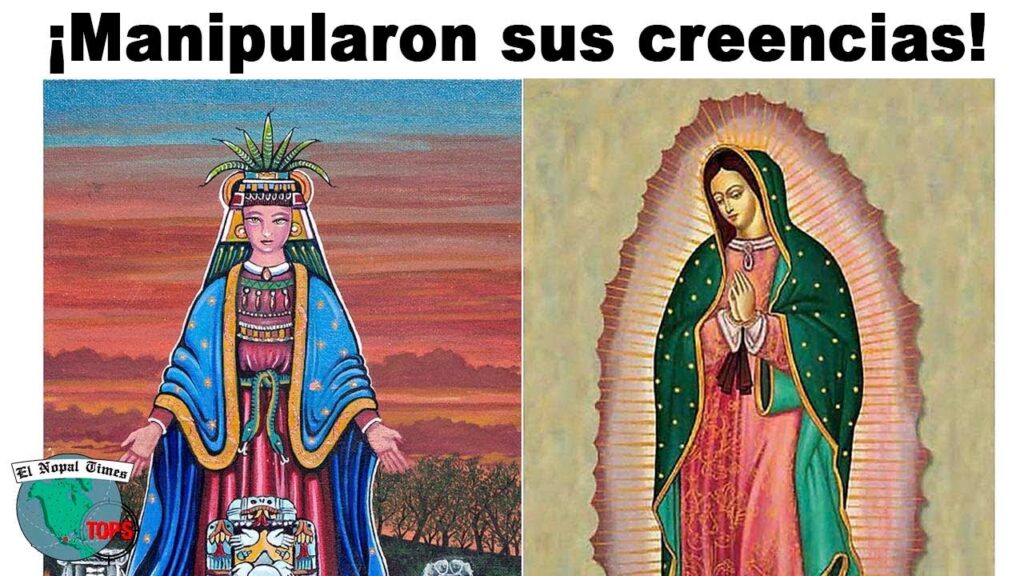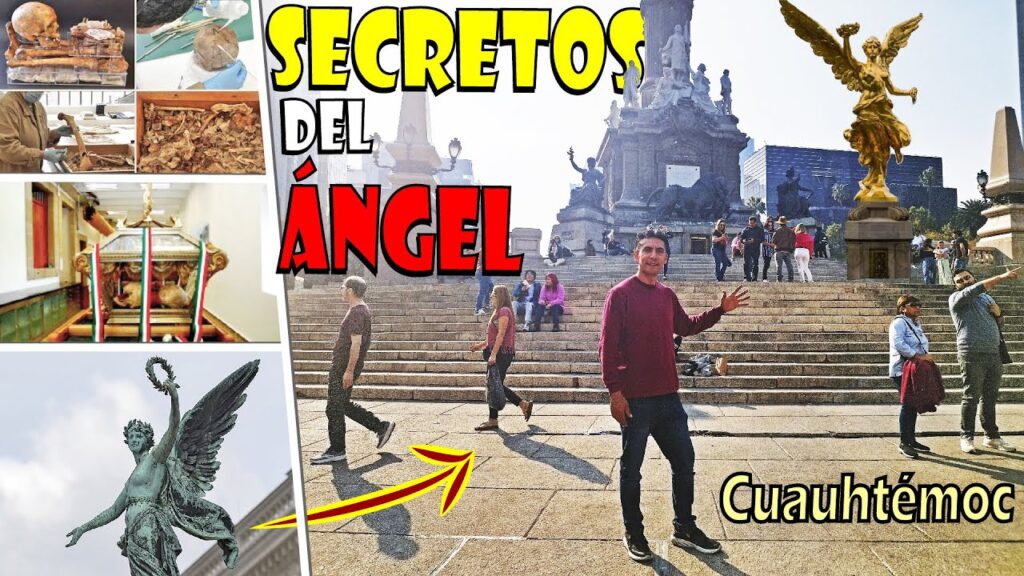The Historical Journey from Tonantzin to the Virgin of Guadalupe
Travelers with a penchant for history and spirituality will find Mexico’s metamorphosis from ancient beliefs to Catholic devotion fascinating. The transformation of the goddess Tonantzin to the Virgin of Guadalupe epitomizes this melding of cultures and religions, creating an adventure into the past that is as mysterious as it is enlightening.
Long before the Spanish conquerors brought Christianity to the New World, the indigenous people of Mexico venerated various deities. Among them was the revered earth goddess Tonantzin, who was believed to provide nourishment and protection to her followers. She was worshipped at the sacred site of Tepeyac, a hill near present-day Mexico City.
In the year 1531, on this same hill, it is believed that the Virgin Mary appeared to a native, Saint Juan Diego. She was radiant, speaking in his native tongue, and requested that a church be built in her honor on that very spot. The Lady, as she appeared, shared features with Tonantzin, embodying the compassion and kindness of the Mother Earth figure.
The resultant blending of the Tonantzin figure with that of the Virgin of Guadalupe can be seen as a symbol of the fusion of indigenous cultures with Spanish colonial influence. The Virgin of Guadalupe became a powerful symbol in Mexico, representing not only religious faith but also cultural identity and resistance to oppression.
Today, the Basilica of Our Lady of Guadalupe stands on Tepeyac hill and is a major pilgrimage site. Travelers visiting Mexico can witness firsthand the deep devotion to the Virgin of Guadapan de Guadalupe. Her image is adorned with elements reminiscent of both Christian and indigenous traditions, which enrich the Mexican cultural tapestry.
Understanding the Significance of “Nuestra Madrecita” in Mexican Culture
In the heart of Mexican culture lies a profound reverence for “Nuestra Madrecita,” a term that embodies the deep respect and affection for mothers and mother figures. This concept extends beyond the biological connection to embrace a broader societal role. Mothers in Mexico are often seen as the pillars of the family, upholding traditional values and nurturing the family unit with both emotional and moral support.
The term “Nuestra Madrecita” is also a reflection of the Virgin of Guadalupe’s influence, who is regarded as the ultimate mother figure and the embodiment of motherhood in Mexico. Her image is not only venerated in religious contexts but also serves as a symbol of national identity and unity. She transcends the personal and enters the collective, representing a mother to all Mexicans, guiding and protecting her children.
In everyday life, the portrayal of mothers as “Nuestra Madrecita” is evident through numerous cultural expressions, from music and art to literature and daily communication. Expressions of love and gratitude towards mothers are deeply ingrained in the social fabric, and Mother’s Day in Mexico is a particularly significant event, celebrated with much fervor and heartfelt emotion. Families come together to honor their mothers with gifts, serenades, and special meals, acknowledging the sacrifices and contributions they make.
But the importance of “Nuestra Madrecita” goes beyond mere familial or religious symbolism. It is a powerful force in shaping gender roles and expectations within Mexican society. Mothers are often idealized as the epitome of selflessness, patience, and resilience. Their role is not only to care for bodily needs but also to instill values and impart wisdom. Consequently, the status of the mother influences social structures, frequently placing women in a revered yet demanding position.
Despite the weight of these expectations, the representation of “Nuestra Madrecita” is also evolving. Contemporary discussions around gender equity and the changing dynamics of the modern family are reshaping the traditional narrative. Today, the figure of “Nuestra Madrecita” continues to be cherished, yet there is a growing acknowledgment of the diversity in motherhood experiences and a recognition that these experiences should not be idealized at the expense of recognizing women’s individual identities, aspirations, and achievements.
Exploring the Vibrant Celebrations of the Virgin of Guadaluepe Day
Every year on December 12th, Mexico becomes a tapestry of devotion and festivity during the celebrations of the Virgin of Guadalupe Day. Considered the patron saint of Mexico, the Virgin of Guadalupe holds a place of unparalleled significance in the country’s cultural and religious identity. The day commemorates the apparitions of the Virgin Mary to Saint Juan Diego on the hill of Tepeyac in 1531, which led to the iconic image of the Virgin emblazoned on his cloak. This historic event is deeply etched into the hearts of the Mexican people, and the day is marked by vibrant celebrations that blend indigenous traditions with Catholic fervor.
In the lead-up to the Virgin of Guadalupe Day, pilgrims from all corners of Mexico and beyond embark on a spiritual journey to the Basilica of Guadalupe in Mexico City, the most visited Catholic pilgrimage site in the world. The atmosphere is electric as the faithful make their way, many on foot and some even on their knees, as a sign of devotion and penance. Individuals and groups can be seen carrying handmade banners and images of the Virgin, singing hymns, and praying rosaries. The basilica’s plaza overflows with a sea of pilgrims, each with their own stories and reasons for undertaking this sacred journey.
The Virgin of Guadalupe Day is also a spectacle of traditional Mexican culture. Colorfully dressed dancers known as “matachines” perform rhythmic and intricate dances to the sound of drums and flutes, offering their art as tribute to the Virgin. Meanwhile, mariachi bands fill the air with festive music, and the scent of burning copal incense mingles with the aroma of street food. Spectators can enjoy a variety of delicious treats such as tamales, tacos, and atole — a warm, corn-based beverage that is a staple during the festivities.
As night falls, the festivities reach their climax with the midnight mass, an emotional and jubilant celebration that is broadcast across the nation. The mass is a profound communal moment where the story of Saint Juan Diego’s apparitions is retold, and a replica of the Virgin’s famed cloak is displayed with reverence. The culmination of the service is met with cheers, applause, and the singing of “Las Mañanitas” — a traditional Mexican birthday song — in honor of the Virgin of Guadalupe. The sense of unity and collective joy is palpable, as millions share in this deeply spiritual and festive occasion, a true reflection of Mexico’s rich cultural tapestry.
From Aztec Roots to Christian Symbolism: The Evolution of December 12th
December 12th holds a place of great significance in the hearts of many Mexicans as it marks the feast day of Our Lady of Guadalupe, the patron saint of Mexico. However, the roots of this date’s importance stretch far before the Christian era, deeply entwined with the rich tapestry of Aztec culture and mythologies. The Aztecs held a particular reverence for this time of year, celebrating the feast of the sun god, Huitzilopochtli. According to the native tradition, this deity played a crucial role in the creation and sustenance of the world, and his followers would offer prayers and perform ceremonies to honor him and ensure the continuance of life.
The arrival of Spanish conquistadores in the 16th century marked a profound shift in the religious and cultural landscape of the region. The Spaniards embarked on a mission to convert the indigenous peoples to Christianity, a quest that would reshape the significance of December 12th. The tale of the Virgin Mary appearing to Juan Diego, an indigenous man, on the hill of Tepeyac in December 1521 was used by the missionaries to win the hearts and minds of the native population. This story not only facilitated the merging of indigenous beliefs with Christian symbolism but also led to the adoption of December 12th as a day of religious celebration in the Christian calendar.
Today, December 12th is a harmonious blend of ancient customs and Christian practices that typify Mexico’s enduring syncretism. The Basilica of Our Lady of Guadalupe in Mexico City, built on the very hill where the Virgin Mary is said to have appeared, is a focal point for millions of pilgrims each year. Celebrations include traditional dances, vibrant processions, and the singing of “Las Mañanitas,” a cherished Mexican birthday song. With each passing year, the festivities serve not only as a reminder of Mexico’s deep Catholic faith but also as a testament to the enduring legacy of its Aztec roots.
Experiencing the Blend of Indigenous and Spanish Traditions in Mexico
Mexico is a tapestry woven with the vibrant threads of numerous indigenous groups as well as nearly half a millennium of Spanish influence. Traveling through its varied landscapes, visitors are presented with a multitude of cultural experiences, enchanting them through a seamless blend of traditions. From the southern states of Chiapas and Oaxaca to the central heartlands of Puebla and Mexico City, every corner reveals aspects of a complex and rich cultural heritage. It’s not just in the grand festivals, but also in the everyday life and practices of the Mexican people where you witness the harmonious coexistence of past and present.
Día de Muertos (Day of the Dead) is perhaps the most iconic celebration that encapsulates this blend of cultures. Indigenous beliefs in the afterlife and the remembrance of ancestors are interlaced with Catholic All Saints’ and All Souls’ Days, resulting in a vibrant festival. During the first two days of November, cemeteries come alive with marigold flowers, food offerings, and the glow of candles, as families gather to honor those who have passed. The rich symbolism found in the ofrendas (altars) and the ubiquitous calaveras (skulls), often seen as sugar candies or artistic representations, showcases a profound view of mortality and reverence for the deceased.
In the realms of gastronomy, no visitor can ignore the tantalizing tastes that arise from the meeting of two worlds. Dishes like mole poblano, with its blend of indigenous chocolate and chili with European spices such as cinnamon and nuts, serve as delicious examples of how culinary practices weave together centuries-old techniques and flavors. Similarly, beverages like pulque, an indigenous drink made from the fermented sap of the agave plant, is often enjoyed alongside introduced liquors like Spanish wine, representing the diversity of the Mexican table.
The union between the indigenous and Spanish is also embodied within Mexico’s artistic landscape. Textile arts in regions like Oaxaca showcase the intricate weaving and embroidery techniques passed down through generations, now often married with European styles and patterns. Architecturally, the country’s skyline is punctuated with structures that blend native construction methods and materials with the baroque influences brought by Spanish colonization. These monuments stand not only as tourist attractions but as living narratives telling the story of a country at the crossroads of time.
Joining the Pilgrims: A Traveler’s Guide to the Basilica of Guadalupe
The Basilica of Guadalupe, nestled in the heart of Mexico City, is not only a central place of worship but also a national symbol of Mexican identity and faith. Yearly, millions of pilgrims travel from far and wide to visit this sacred site, which is dedicated to the Virgin of Guadalupe. As a traveler eager to experience this profound pilgrimage firsthand, understand that this journey is as much about the cultural immersion as it is about spiritual seeking.
In preparation for your visit, it’s important to acquaint yourself with the history and traditions surrounding the Basilica. Legend has it that in December 1531, the Virgin Mary appeared to a humble indigenous man named Juan Diego on the hill of Tepeyac, the very site where the Basilica stands today. The event is commemorated each year on the 12th of December, a day when a sea of believers converges on the Basilica to pay homage. Taking part in this annual event, whether as an observer or a participant, is a powerful experience that is sure to form a lasting memory.
As you walk the same paths that countless pilgrims have trod before, you will witness a vibrant tapestry of Mexican culture. From the Peoples’ Plaza to the Old Basilica and the modern structure that dominates the skyline, every corner of the sacred complex tells a story. Remember to dress modestly out of respect for the religious nature of the site, and always approach the shared areas with courtesy. Keep your eyes and heart open to not only the religious significance but also the profound human connection that this pilgrimage offers to visitors from around the globe.



